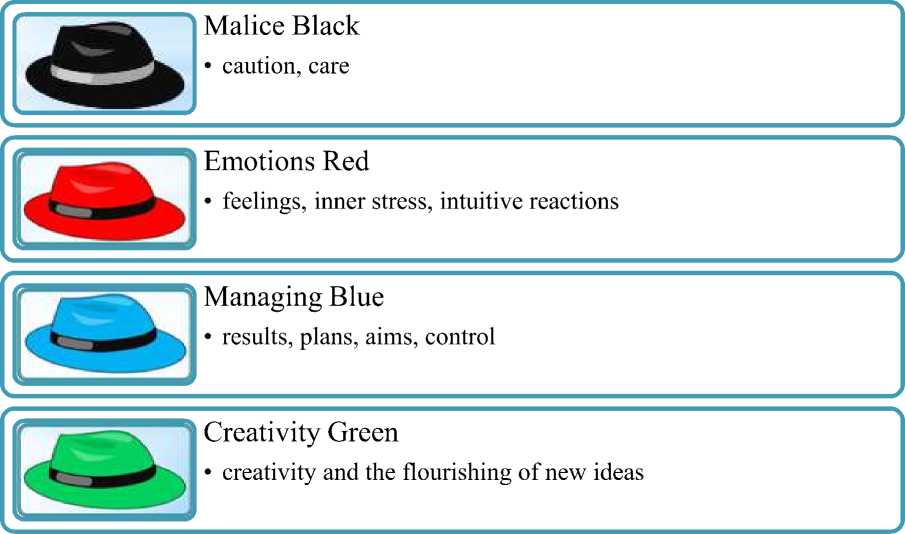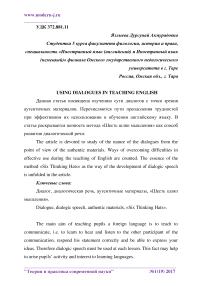Using dialogues in teaching English
Автор: Yazlyeva D.A.
Журнал: Теория и практика современной науки @modern-j
Рубрика: Образование и педагогика
Статья в выпуске: 1 (19), 2017 года.
Бесплатный доступ
The article is devoted to study of the nature of the dialogues from the point of view of the authentic materials. Ways of overcoming difficulties in effective use during the teaching of English are counted. The essence of the method «Six Thinking Hats» as the way of the development of dialogic speech is unfolded in the article.
Dialogic speech, authentic materials, «Six Thinking Hats»
Короткий адрес: https://sciup.org/140289351
IDR: 140289351
Текст научной статьи Using dialogues in teaching English
Dialogue, dialogic speech, authentic materials, «Six Thinking Hats».
The main aim of teaching pupils a foreign language is to teach to communicate, i.e. to learn to hear and listen to the other participant of the communication, respond his statement correctly and be able to express your ideas. Therefore dialogic speech must be used at each lesson. This fact may help to arise pupils’ activity and interest to learning languages.
Dialogue is a written or spoken conversation between two or more people, a form of speech consisting of an exchange of remarks. Dialogic speech is an effective form of learning activities to consolidate and practice grammatical structures, vocabulary, and cultural realities.
Dialogic speech can be a helper at all stages of the lesson. At the stage of introduction short dialogues can be directed to the development of pupils’ interest to the topic. Dialogue-exchange of views can be really fruitful in introducing the text for reading or listening, tasks in writing, and especially in preparation for essay writing. Dialogue-discussions that are set after reading the text, listening to audio file also solve several educational tasks such as a replenishment of the vocabulary, training of dialogical speech, broadening the outlook, fostering tolerance and mutual respect in children to the opinion of other participants of the conversation.
As we have already mentioned above dialogues being a kind of authentic materials can help at any stage of checking tasks focused on the development of language skills. Collective discussion of selected or created variants of answers to assignments in reading, enlarging vocabulary, training grammar, and listening solves not only problems of checking, motivation, shyness, fear of making a mistake, but also gives more time at the lesson to develop speaking skills.
Ways of overcoming difficulties in teaching dialogical speech
At the organization of educational activities aimed at developing speaking skills, including dialogical communication, the teacher should guide modern approaches to learning. Some traditional approaches to teaching speaking pay more attention to the grammatical correctness of speech, in consequence, unwillingness to speak due to a fear of making mistakes, problems and difficulties may occur in the process of learning the English language.
A modern approach to learning a conversation basis may follow the next key points to overcome possible difficulties in teaching dialogical speech:
-
• Personalization – i.e. pupils make tasks more willingly and
successfully which suggest describing their life experience and imagine themselves in the place of the personage.
-
• Building dialogues in the way which pupils may vary and create
their own storyline and display individuality.
-
• Working more in pairs, groups, as it eliminates the problem of
shyness and leads to the cohesion of the class, and moreover provides an opportunity to increase the time of speaking practice at the lesson.
-
• Striking a balance between the correctness of speech and fluency of
language, the teacher must be aware that the grammatical correctness of speech should not be concentrated in spontaneous speech and at the stage of learning.
-
• The teacher’s task is to provide pupils with tools for the successful
conducting conversation and give time for preparation, if the task suggests the use of new vocabulary, grammar or speech units, which will certainly affect the lexical and grammatical filling and speed of speech in performing a dialogue.
-
• The teacher should give pupils possibility to talk more in the
classroom, minimizing his/her own speaking time.
For language fluency and ability to converse in English, pupils must initially know the vocabulary of the interlocutor, be able to agree/disagree, use a variety of phrases to express opinions, propose and ask for information [1].
It is advisable to use visual materials with the aim of teaching pupils the vocabulary. It can be demonstrated on the board, or as a poster or a handout which will serve as a reference material for pupils while they are not able to speak fluently on particular theme.
Here is an example of the visual material for using the vocabulary of the interlocutor:
Introductory words: first of all, initially, by the way, in other words, the thing is, if I’m not mistaken, on the one hand, on the other hand, in a word, in short, as far as I know and so on.
Ways of expressing (dis)agreement: perhaps, probably, how come, absolutely, sure, of course, I (don’t) think so, on the contrary, I (dis)agree with you, in a way, no way, most likely, quite so and etc.
Ways of keeping the conversation and responding to remarks: May I ask you a question?, repeat it again, please, how are things going with you?, it’s new for me, you don’t say so, did I get you right?, it doesn’t matter, never mind, good luck and etc.
A technology of critical thinking development being one of the effective methods in teaching foreign languages helps to enhance critical thinking skills of pupils from the very beginning of the study. Critical thinking is the starting point for the development of creative thinking.
In the article we decided to reveal the essence of the method «Six Thinking Hats» as a means of conducting a dialogue and increasing interest to the theme. We know that the initial phase of mental activity is connected with the realization of problem situation. A problem that is put correctly provokes pupils to find the relevant solution and engage in dialogue. Dialogic speech helps to the movement of the logos, words and thoughts to understand ideas. Pupils readily work and cooperate in groups, help each other in reaching the truth.
«Six Thinking Hats» is a system designed by Edward de Bono which describes a tool for group discussion and individual thinking involving six coloured hats. Each of the six hats has its own, individual colour. The colour difference makes each hat a special and unique. The six directions are:

Information White
-
• objective true facts, information, available questions

Optimism Yellow
• advantages, benefits, seeking harmony, sunny side of situations

Pupils easily cope with different roles in the form of a game and don’t hesitate to join the conversation or discussion. They can make dialogues themselves using different roles of the hats.
Successful integration of such method can let the teacher enliven lessons and develop communicative competence by using real-life situations according to learner-centered approach.
Список литературы Using dialogues in teaching English
- Spratt, M. "The Practice Stage, Discourse Chains". In At the Chalkface: Practical Techniques in Language Teaching, eds. A. Matthews, M. Spratt, and L. Dangerfield. Walton-on-Thames, UK: Thomas Nelson, 1991


